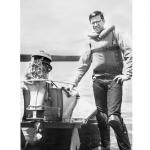From these previous pictures is a Red class A Alky block that had the extra 2 ports added to one cylinder only and not the other. Clearly it was run that way for a longish time and for some benefit as other blocks had 2 extra ports per cylinder added and that was for the Anzani A. The Anzani B Alky block seems even more extreme with added ports.
The fire clearly got hot when the castiron Anzani loop block with its exhaust plugs to keep the exhaust square going into the megaphone exhaust pipe melted and spread out into more of the exhaust port.


 Thanks:
Thanks:  Likes:
Likes: 






Bookmarks